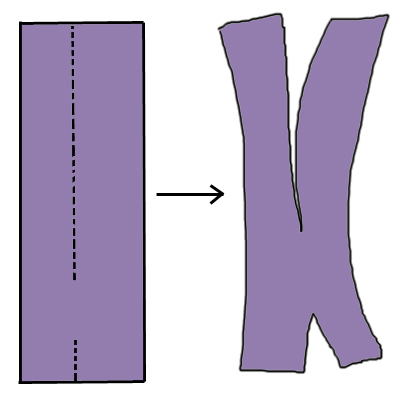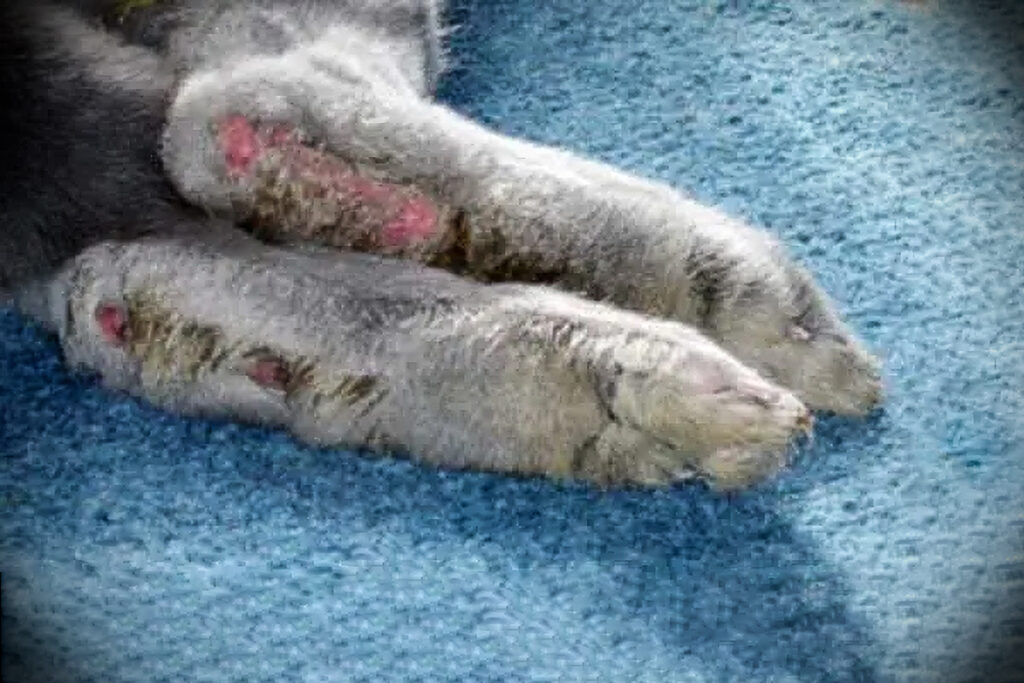Sore hocks, a common foot condition in which the sole of a rabbit’s foot becomes raw and inflamed, can be caused by a number of different problems. We’ll discuss some common causes and the recommended treatment.
Causes of Sore Hocks
IMPROPER FLOORING
Rabbits need soft, preferably malleable flooring that will mimic the natural texture of the earth as much as possible. Wire flooring that doesn’t have sufficient support underneath is not appropriate, as it can cause the foot to bow unnaturally. (Wire flooring with proper support is all right as long as you have a clean litterbox and soft bedding on top of it.) Wood, tile, or linoleum flooring can also be problematic, as it doesn’t allow the foot to bend the way it does when it’s pushing off against earth or grass. Cages with slick plastic bottoms are especially bad for a bunny’s feet and joints. Lack of traction can cause painful problems in the pelvic and pectoral joints, leading to arthritis, and even splay leg. An indoor rabbit needs soft cotton mats with rubber backing to provide enough traction for healthy locomotion.
OBESITY
A rabbit with too much weight on her body will often not be able to stand correctly, and may put unnatural pressure on points of her feet that are not meant to support much weight. This can cause sores.
ARTHRITIS OR OTHER SKELETAL PROBLEMS
Pain from arthritis in the pelvis or spine–or skeletal pain for any other reason–can cause a rabbit to posture in an unnatural way, resulting in pressure on delicate points of the feet.
INSUFFICIENT FUR PADDING ON THE FEET
Any cause of fur loss on the soles of the feet (e.g., mange, friction from improper flooring, contact allergies etc.) will deprive the rabbit of the natural padding she needs to protect her feet. Rabbits have little or no fat padding on the bottoms of their feet; they rely almost exclusively on a thick pad of wool to protect them from impact and friction. (NOTE: Some rabbit breeds, particularly Rex rabbits, have very fine fur that doesn’t hold up well to friction. These breeds seem particularly prone to sore hock problems.)
The problem can be painful, and if not treated properly, can progress to very serious conditions such as bone infections. A rabbit with sore hocks should be examined and treated by a good rabbit vet, especially if there are open sores that might need antibiotics or other medical intervention.
The following diagrams show how you can safely wrap your rabbit’s feet in special “booties” that will protect the bare areas of her feet to prevent sore hocks, if she is showing signs of fur loss on her soles.
IF THERE ARE OPEN SORES ON YOUR RABBIT’S FEET, DO NOT WRAP THEM AS SHOWN BELOW UNTIL YOU HAVE HAD THE SORES EXAMINED AND PROPERLY TREATED BY AN EXPERIENCED RABBIT VETERINARIAN. OPEN SORES MAY NEED TO BE TREATED, AND THE FEET RE-WRAPPED, DAILY. WRAPPING AN OPEN SORE WITHOUT TREATING IT APPROPRIATELY CAN RESULT IN SERIOUS INFECTION.
Do not attempt this wrapping procedure without the guidance of a good rabbit vet who can check on the rabbit’s progress and change the wrapping and medication as necessary!

Sore Hocks Treatment
STEP ONE
Obtain a generous wad of “spare” rabbit fur from a healthy rabbit who has been shedding. (A fine-toothed flea comb can be useful for allowing you to gently harvest the extra fur.) Roll it between your palms until it forms a soft, spongy, but firm mat of “felt” that’s about 2″ x 2″ x 1″ (deep). Other types of padding are NOT recommended, as they tend to compress into hard mats that may do more harm than good. Please DO NOT TRY THIS until you are able to get some shed rabbit wool! Cotton, gauze, or any other padding just do NOT work as well as The Real Thing.
STEP TWO
Cut a strip of VetWrap self-adhesive bandage, about nine inches long and two inches wide. Take this strip and cut it into an “H” shape, as shown in the diagram below. Leave about one inch UNCUT in between the “H” cuts, as shown. This uncut portion will cover the rabbit’s heel.

STEP THREE
While one person firmly holds the rabbit belly up, the other should press the felt pad against the sole of the foot, gently folding as much of the rabbit’s own foot fur over the bare spot as possible. Holding the fur in place, position the VetWrap as shown below:

STEP FOUR
Being careful not to wrap too tightly (you should be able to insert your a tongue depressor between the bandage and the leg, and not have it stick), wind the vet wrap above and below the hock (ankle), as shown. You may have to try this a few times, as the felt pad can be slippery, and the VetWrap hard to handle.

STEP FIVE
The “almost finished” bootie should look like this:
STEP SIX
When the rabbit bends her ankle, the VetWrap on the top of her ankle can bunch together and cause painful pinching. To prevent this, you must carefully excise a small “window” (either diamond or circle-shaped) out of the wrap on top of her ankle, to prevent this! Use blunt-tipped scissors, and be extremely careful to cut away the bandage one layer at a time so you don’t accidentally cut the rabbit!

STEP SEVEN
Be sure to check the foot carefully several times over the next few hours to make sure there’s no swelling or redness. If there is, you’ve wrapped it too tightly! Unwrap it immediately, let the foot “rest” for a while, and then try again.

Conversely, if wrapped too loosely, the bandage could spin around or slide up the leg and bunch up against the ankle or knee. Practice and careful observation of what works will lead to a “bootie” with the proper tension. This style of wrapping rabbit feet with bare spots (NOT open sores) should keep the rabbit comfortable for a good while, but we generally re-wrap and re-pad every week or so. If the pad or bandage becomes wet or soiled, change it immediately, as you don’t want an already compromised foot soaking in water (or worse!).
Eventually, you should see a return of normal fur growth. While your vet is treating the problem that caused the sore hocks in the first place, there’s no need to leave those cute feet unprotected. GOOD LUCK!

